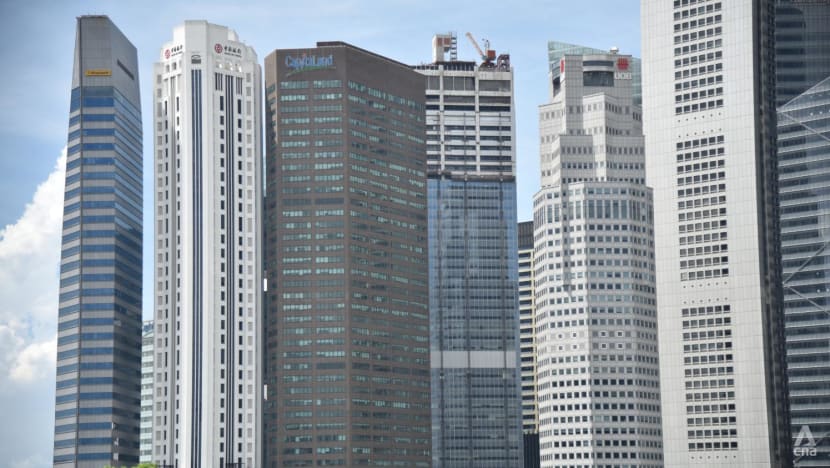Singapore's economy grew 2.9% in Q2 of 2024: MTI advance estimates
The manufacturing sector returned to growth in the second quarter, expanding 0.5 per cent compared with a year ago, reversing a contraction of 1.7 per cent in the first quarter.

File photo of the central business district (CBD) in Singapore. (Photo: CNA/Syamil Sapari)

This audio is generated by an AI tool.
SINGAPORE: Singapore's economy grew 2.9 per cent in the second quarter of the year compared with the same period a year ago, according to advance estimates from the Ministry of Trade and Industry (MTI) on Friday (Jul 12).
This was slightly slower than the 3 per cent growth recorded in the first quarter of 2024.
On a quarter-on-quarter seasonally-adjusted basis, Singapore's economy expanded 0.4 per cent in the April to June period, slightly faster than the 0.3 per cent reported in the first quarter.
Advance gross domestic product estimates are computed largely from data gathered in the first two months of the quarter.
They are intended as an early indicator of GDP growth for the quarter and may be revised when more comprehensive data is available, the ministry said. The advance estimate for GDP in the first quarter was 2.7 per cent, but was revised to 3.0 per cent.
MANUFACTURING SECTOR RETURNS TO GROWTH
The manufacturing sector grew 0.5 per cent in the second quarter compared with a year ago, reversing a contraction of 1.7 per cent in the first quarter.
"Growth in the sector was supported by output expansions across all manufacturing clusters, except for the biomedical manufacturing and precision engineering clusters," MTI said in its release.
On a quarter-on-quarter seasonally-adjusted basis, the sector expanded by 0.6 per cent, compared with the 5.3 per cent contraction of the first three months of the year.
The group of sectors comprising the information and communications, finance and insurance and professional services sectors recorded the biggest growth of 5.6 per cent in the second quarter, though it was a slight moderation from the 5.7 per cent expansion in the previous quarter.
In the information and communications sector, growth was supported by continued strong demand for IT and digital solutions. For the finance and insurance sector, activities supplementary to financial services, banking and fund management segments supported growth.
On a quarter-on-quarter seasonally adjusted basis, the group of sectors grew 1.4 per cent. It shrank 2.8 per cent in the previous quarter.
The construction sector extended growth, expanding by 4.3 per cent in the second quarter, versus 4.1 per cent in the first quarter. The growth was boosted by an increase in public sector construction output.
On a quarter-on-quarter seasonally adjusted basis, the construction sector was back in the black at 2.4 per cent, compared with a contraction of 1.9 per cent in the first quarter.
The group comprising accommodation and food services, real estate, administrative and support services and other services grew 1.9 per cent in the second quarter, down from 3 per cent in the first quarter.
Besides the real estate and food services sectors, all other sectors in the group expanded.
"In particular, growth in the accommodation and administrative & support services sectors was supported by the sustained recovery in international visitor arrivals," MTI said.
On a quarter-on-quarter seasonally-adjusted basis, the sectors in the group collectively contracted by 0.5 per cent, a pullback from the 2.3 per cent growth in the first quarter. A slew of concerts in the first three months of the year was said to have boosted consumer-facing industries that quarter.
The wholesale and retail trade, and transportation and storage sectors collectively expanded by 2.5 per cent from a year ago, moderating from the 3.9 per cent growth in the first quarter.
All sectors in the group recorded growth except for retail trade, which shrank because of a decline in sales volumes of wearing apparel and footwear, watches and jewellery and optical goods and books.
Growth in the transportation and storage sector was mainly supported by water and air transport, while wholesale trade growth was driven by machinery, equipment and supplies, and other segments.
On a quarter-on-quarter seasonally adjusted basis, the sectors expanded 0.7 per cent as a group, down from 2.7 per cent in the first quarter.
FORECAST AND OUTLOOK
Ms Selina Ling, chief economist and head of global markets research and strategy at OCBC, said the second quarter's growth was better the 2.7 per cent that the bank forecast.
She noted that manufacturing and construction saw sequential growth improvements on a quarterly basis.
"However, services momentum came off from the high base in 1Q24 which was boosted by the spate of big artist concerts which drew large visitor arrivals," she said.
Though the third quarter will see Singapore hosting the Formula 1 Grand Prix race and other high-profile events, Ms Ling said OCBC does not expect a repeat of the growth surge seen in the first three months of this year.
Given that the second half of 2023 is a higher base, economic growth in July to December period of this year is likely to be closer to 2 per cent, she added.
Still, OCBC is upgrading its full-year GDP growth forecast from 2.3 per cent to 2.6 per cent to account for the growth in the first half of the year. The external economic environment has improved, but the geopolitical landscape has "remained fraught", with the US presidential elections being the key risk on the horizon.
The market may anticipate higher tariffs in the event that Trump wins, and there could be potential frontloading on the trade front.
"This may ironically be a tailwind for 2H24 manufacturing and trade for the region," she said.
















